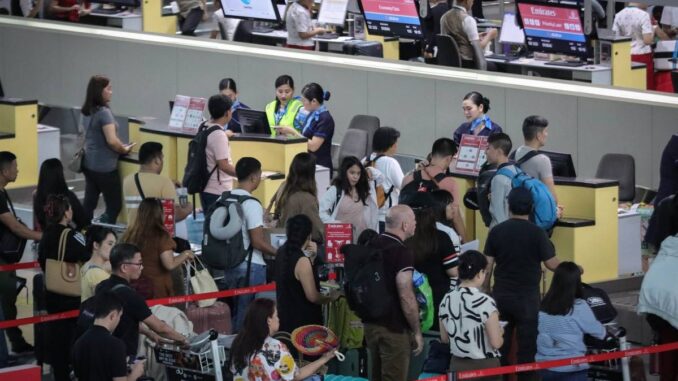
(UPDATE) THE number of Filipinos working abroad surged to 2.16 million last year, data from the Philippine Statistics Authority (PSA) showed.
From April to September 2023, the number of overseas Filipino workers (OFWs) reached 2.16 million, 9.8 percent higher than the 1.96 million recorded in the same period in 2022, with overseas contract workers (OCWs) making up 98.1 percent of the total.
The remaining 1.9 percent were those working full-time using tourist, visitor, student, or medical visas.
Of the total, 1.20 million, or 55.6 percent, were women. The largest group of Filipino workers were aged 45 and over (24.1 percent), followed by those aged 30-34 (23.5 percent) and 35-39 (18.6 percent).
Sixty-six percent of the workers were from Luzon, 17.6 percent from Mindanao, and 16.5 percent from Visayas.
Among male OFWs, those ages 45 and older made up the largest group at 29.2 percent, 9.2 percentage points higher than females in the same age group.
In terms of occupation, around 41.1 percent of Filipino workers held elementary jobs or those who performed simple tasks.
Service and sales were the second most common at 14.7 percent, followed by plant and machine operators and assemblers at 12.1 percent.
Most Filipino workers were spread across Asia (77.4 percent), followed by North and South America (9.8 percent), Europe (8.4 percent), Australia (3.0 percent), and Africa (1.3 percent).
Saudi Arabia was the top destination, hosting 20 percent of OFWs, followed by the UAE at 13.6 percent.
Singapore had the lowest number of Filipino workers, making up 3.9 percent of the total.
Rizal Commercial Banking Corp. chief economist Michael Ricafort said the rise in Filipinos working abroad is due to the higher wages and benefits.
Ricafort attributed the increase in Filipino workers in Saudi Arabia to the strong diplomatic relations between that country and the Philippines.
“This is a win-win for both the host countries for OFWs and for the Philippines since OFW remittances are more than $40 billion per year, or the 4th largest in the world after India, Mexico, and China,” he said.
“For the coming years, there would still be more Filipinos to take the opportunity to earn more for their families through overseas employment as an option,” he added.
The PSA found that 37.3 percent of OFWs sent cash remittances of P40,000 to less than P100,000, while 30.9 percent sent at least P100,000. However, 12.4 percent did not send any cash remittances during this period.
Total remittances from OFWs amounted to P238.63 billion, including P187.11 billion in cash, P44.70 billion brought home, and P6.81 billion in kind.
The average remittance of Filipino workers from April to September 2023 was P123,000, up from P111,000 during the same period in 2022.
Of the P187.11 billion in cash remittances, P129.20 billion, or 69.1 percent, came from OFWs working in Asian countries, the PSA said.







Be the first to comment